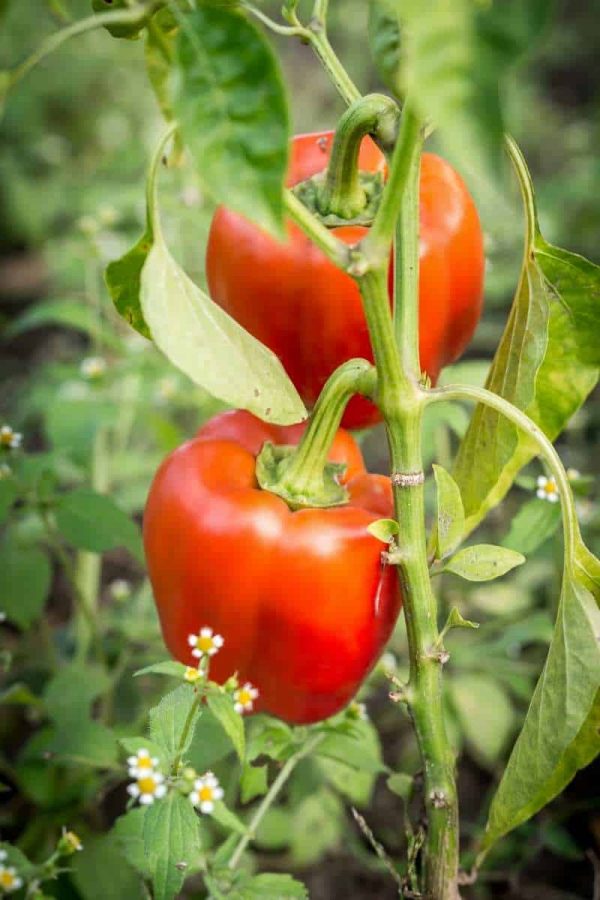Bell peppers are a great addition to your home garden. Not only are they relatively easy to grow (as long as you know some of their quirks), but they are also one of the veggies where you can really save some serious cash by growing your own. No need to shell out $3 a pop for an organic red bell pepper—instead plant a single pepper plant and get dozens of peppers that you can use fresh, freeze, dehydrate, or roast!
We’ve been growing bell peppers for decades in the Growfully Gardens, and we’ve pulled together all of our best tips and tricks so you can have pepper success, too! Let’s dive in.

Table of Contents
Are bell peppers easy to grow?
Bell peppers can be fussy about their growing temperature, so they can be tricky for gardeners in climates with shorter growing seasons. We consider bell peppers to be more of an intermediate-level vegetable to grow—especially if you are growing them from seed. But if you buy seedlings or have hot, long summers, then peppers will be a breeze for you!
Growfully Protip
The growing conditions for sweet bell peppers and hot peppers is mostly the same. The only difference between these two plants is the level of capsaicin (the chemical compound that makes spicy peppers spicy)—but you can use the same growing information here to grow jalapeños or other spicy peppers, too!
Do bell peppers need full sun?
Yes! Peppers are sun-loving, heat-loving vegetables that need six to eight hours of direct sunlight a day. If you grow them in the shade, they’ll be stunted and produce far fewer flowers and peppers than they would if grown in full sun.
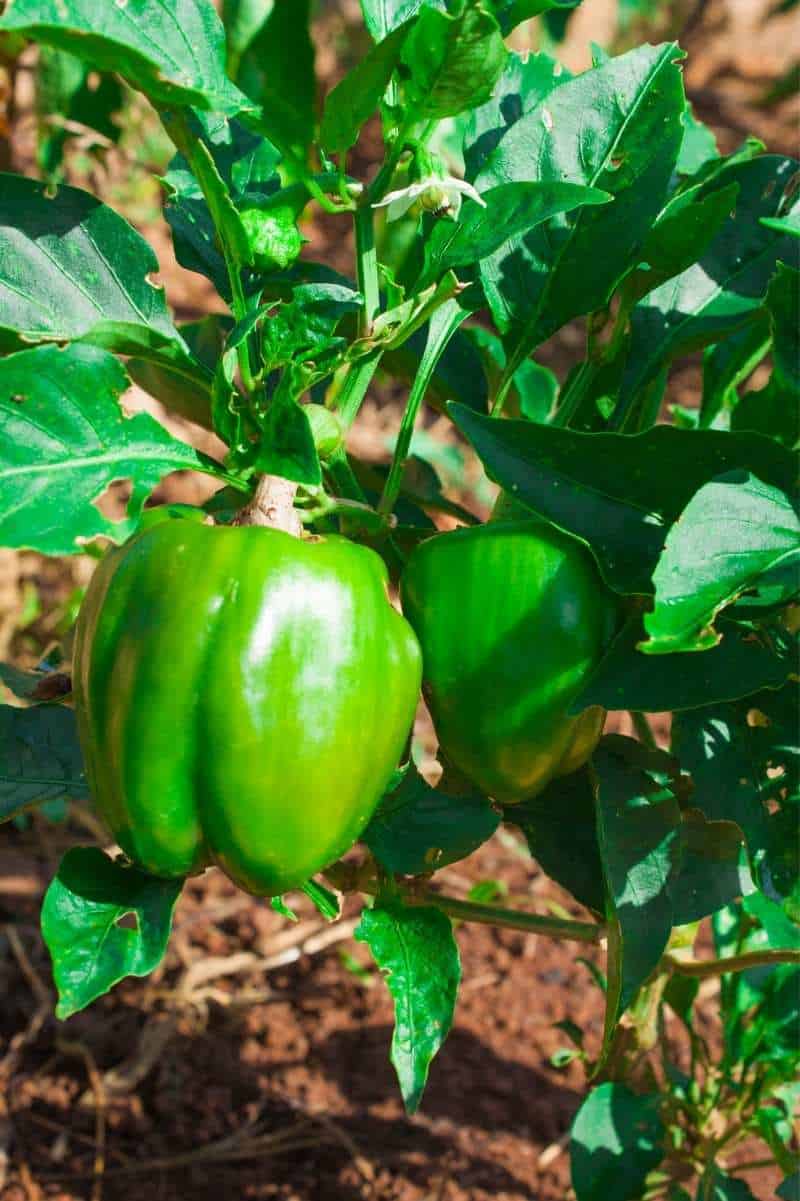
What are the best conditions for growing bell peppers?
Bell peppers require plenty of heat, sunlight, and water. They grow best in well-draining soil with a good supply of phosphorus and calcium. Don’t grow them in soil too high in nitrogen because the nitrogen will cause additional foliage growth with minimal fruit production. Try to avoid planting your peppers anywhere tomatoes, other peppers, potatoes, or eggplant have recently grown.
Growfully Protip
Peppers like to dry out almost completely before being deeply and evenly watered again. This makes them a great option for areas that have drought-spells in the summer.
What are the best varieties of bell peppers?
Bell peppers are a sweet pepper known for their blocky, square shape. They commonly come in green, red, yellow, and orange; however, you can also find bell peppers that are purple, white, or brown. All bell peppers start out green and mature to a brighter color. The longer you leave the pepper to mature, the sweeter it is. If you want a green bell pepper for your pizza, just harvest any of your colorful bell peppers early!
Although there are different varieties of peppers, the major difference is the color they mature to and the length of their growing season. Some popular bell pepper varieties are:
- Ace: A classic large bell pepper that starts green and matures through yellow and orange to red.
- California Wonder: A huge bell pepper that starts out green before it turns dark red.
- Purple Beauty: As the name suggests, this pepper matures to a purple color which will turn dark purple/red if left on the plant.
- Orange sun: A sweet bell pepper that matures into a beautiful orange.
- Sweet Chocolate: This bell pepper is relatively cold tolerant, and it matures into a dark brown with a mild flavor.
- Sweeties: If you love the mini lunchbox peppers you get in the store, these small-sized sweet peppers are a must for your garden!
- Mini Bells: These peppers come in all kinds of fun colors, and they look exactly like miniaturized bell peppers. They are a super fun addition for a kid’s garden.
Growfully Protip
Myth alert! You may have heard that female bell peppers have four lobes and are sweeter, while male bell peppers have three lobes and are better for cooking. This is a myth. Bell peppers do not have biological sex, and the number of lobes on the bottom is determined by growing conditions and pepper variety.
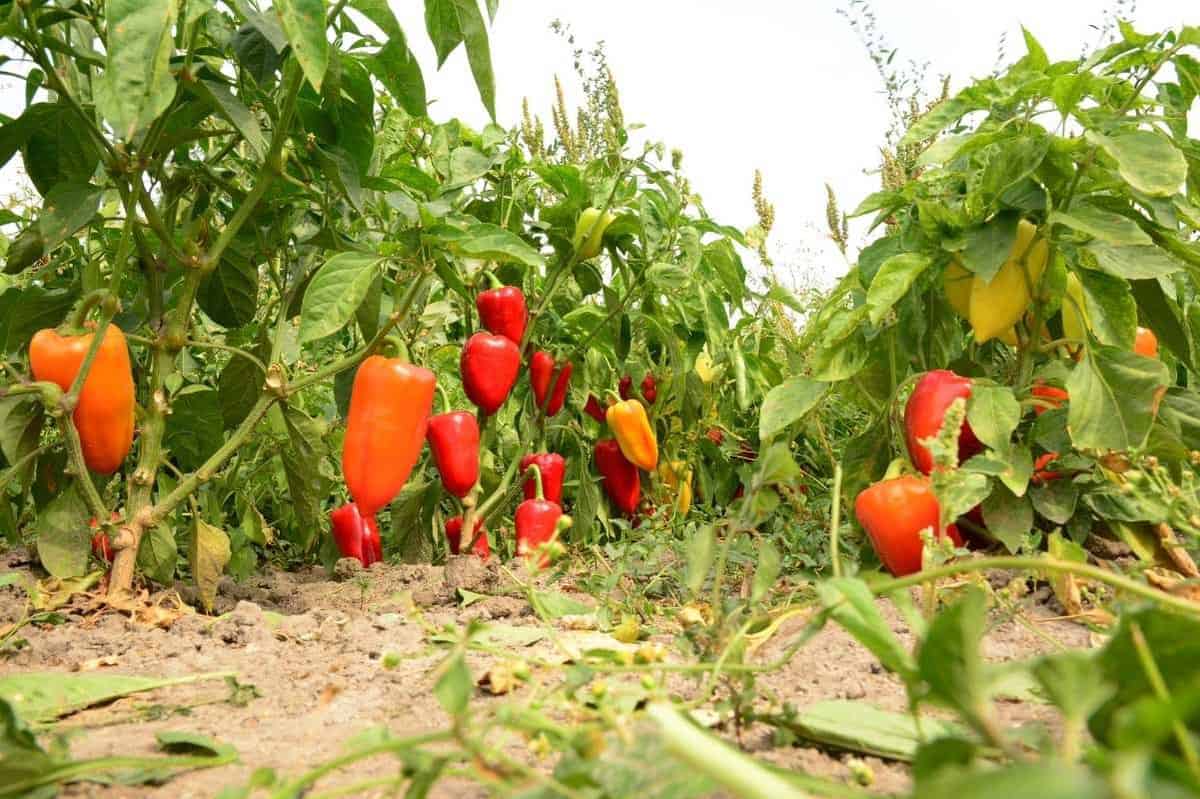
What is the best bell pepper variety to plant?
If we only could pick one bell pepper to pop in our garden, it would be California Wonder. These huge bell peppers produce great green peppers and red peppers, their flesh is thick and crunchy, and they freeze beautifully.
Where should I plant my bell peppers?
Choose a location that gets plenty of sunlight to grow your bell peppers. Ensure that the area you choose has loose, well-draining soil so your pepper plants don’t get waterlogged roots. You can grow peppers in various sites, including garden beds, pots, containers, and raised beds. They’re relatively compact and don’t take up a lot of room.

How long does it take to grow bell peppers?
Days to maturity will depend on the pepper variety (check the seed packet). For most varieties, if you start your seeds indoors eight weeks before you transplant them outside, you can expect to harvest green peppers beginning around day 60 after transplanting and then fully ripe peppers 2-3 weeks after that.
When do I plant bell peppers?
Because bell peppers require a longer growing season with plenty of heat, it’s best to start your seeds indoors in the vast majority of climates. Seed should be started indoors about 8-10 weeks before your last frost date.
Bell peppers love warm weather, so make sure to keep your pepper seedlings warm at all times. We highly recommend using a seed mat and humidity dome on your pepper plants to keep the soil and air temperature above 80ºF.
Don’t move them outside until soil temperatures are at least 70°F and nighttime temps don’t drop below 55°F. When your soil warms to this temperature will depend on your growing zone; however, most people won’t plant bell pepper transplants outdoors until 1-2 weeks after their last frost date.
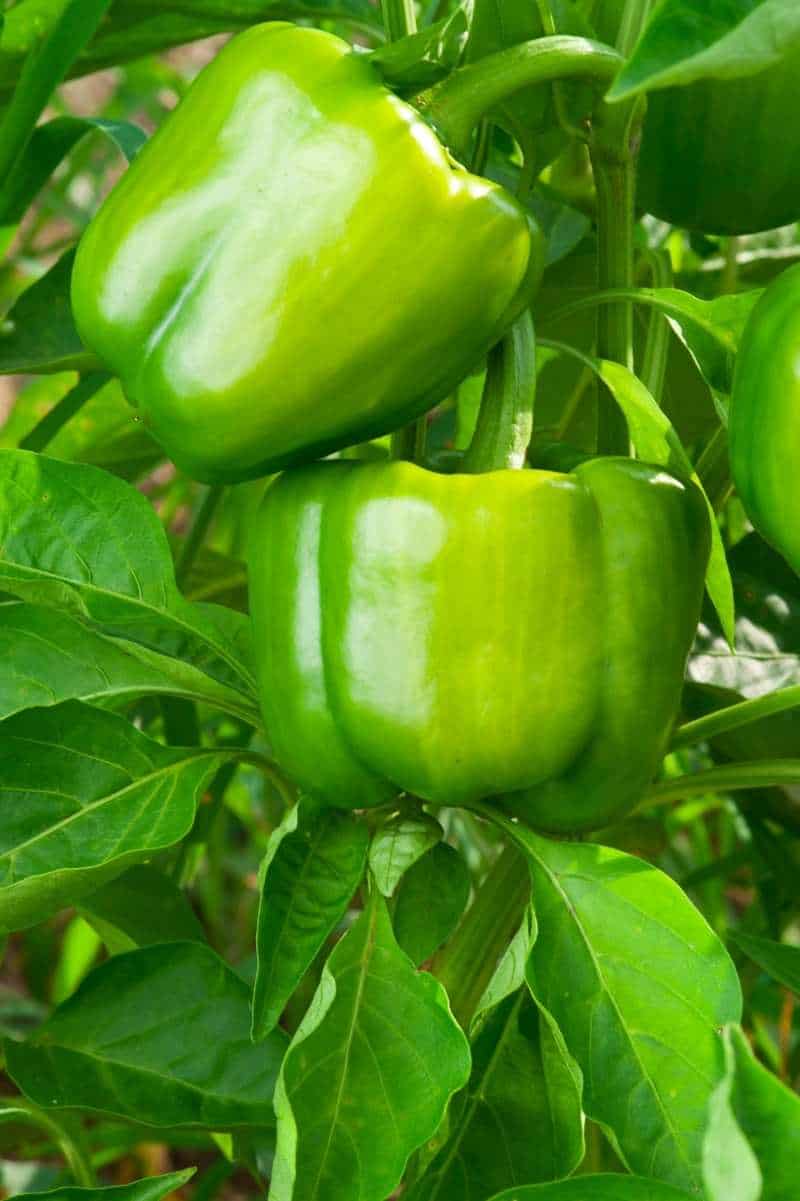
Should I start my bell peppers indoors?
Yes! It’s highly recommended that you start your bell pepper seeds indoors to give your plants a head start on the long growing season in the warmth they require.
How to grow bell peppers from seed
Peppers require a long warm growing season that’s best obtained by starting your plants indoors. We don’t recommend you direct sow bell pepper seeds because by the time the soil has warmed enough for your plants, they won’t have enough warm days to produce fruit properly.
Growfully Protip
If you don’t have the room or equipment to start seeds indoors, you can usually find starter bell pepper plants at your local garden store or nursery in the spring. If you buy starter plants, be sure to keep them in a warm location until temperatures have warmed outdoors and harden them off before planting.
To start seeds indoors for the best pepper plants:
- Fill your seed starting trays, pots, or soil blocks with seed starting mix.
- Sow 2-3 seeds per spot about 1/4 inch deep. Cover the planted seeds with a humidity dome.
- Use a heat mat under your tray to keep the soil between 80°-85°F. Keep your peppers under a grow light for 16 hours a day if possible to encourage growth.
- After your seedlings have reached a few inches in height and have at least one set of true leaves, thin out the seedlings so there is only one per spot.
- After a few weeks, when your plants have around eight leaves—or you can see roots in the drainage holes—pot them up again into a larger pot, burying the stem up to the first set of leaves. Potting up the pepper plants and burying the stem each time helps to create a stronger root system and stronger stem..
- Continue increasing pot sizes as your peppers outgrow their pots until it’s time to plant them out in the garden.
Growfully Protip
Some folks like to pinch their pepper plants by snapping off the top two sets of true leaves after a pepper plant has grown 4-8 sets of true leaves. In theory, this forces the pepper to produce more side shoots and create a shorter, stockier plant that produces more peppers on more stems. We’ve done it both ways in the Growfully Gardens (pinched and unpinched) and haven’t seen much difference—but it’s worth a shot if you’re interested in experimenting.

How to transplant pepper plants outdoors
- Prepare your soil. Bell peppers like rich, balanced soil that’s rich in calcium and phosphorus to help produce healthy peppers. Test your soil before planting and amend as necessary.
- Warm the soil. If you live in a cooler climate and you want to get your pepper seedlings outdoors earlier, you can warm the soil by covering it with a piece of black plastic to help raise the soil temperature to the 70°F necessary for growing peppers.
- Plant your bell pepper transplants when the soil has warmed to at least 70°F. Place your plants a foot apart, close enough that their largest leaves will barely touch one another when they mature. Dig a hole and carefully lay your pepper seedling down. You can bury your seedling up to the first set of leaves for a more robust plant.
- Cover your bell pepper transplants with a light row cover until temperatures reach 85°F or until flowers appear. The row cover will help retain heat while keeping insects and pests away from your bell pepper plants.
Growfully Protip
Pepper plants need to be a bit crowded (leaves of one mature plant just should touch the leaves of another) to prevent the peppers from getting sunscald. These are spots on peppers that are caused by the fruit being exposed to too much sun. The canopy of lush green leaves from your plants should protect them—but only if they are bunched together with about 12 inches of spacing between each plant.
How to grow bell peppers in containers
Bell pepper plants stay reasonably small and compact, making them an excellent choice for container planting. Choose a container that’s large enough to hold your pepper plant—a pot that’s 12 inches in diameter is perfect. If you’re planting directly into this pot, you can plant three seeds per pot, thinning to one plant once they’ve received their first few sets of true leaves. If you’re transplanting pepper seedlings to a container, keep it to one seedling per pot.
All plants grown in containers will need more frequent watering than plants grown in the ground. Peppers can handle being dried out, but once the soil is dry down 1-2 inch deep, it’s time to water. Your bell pepper plants will benefit from occasional feeding using a balanced fertilizer—we like diluted fish emulsion and liquid kelp.

Do bell peppers need trellising?
No, bell pepper plants are compact enough that they don’t need a trellis. If your pepper plants are growing a little top-heavy, they will benefit from a stake or cage of some sort. Small tomato cages are the perfect size and shape to support your growing bell pepper plants.
How do I care for my growing bell pepper plants?
Germination and the early days are the most challenging part of growing peppers. Once your transplants are in the ground, they require the same basic care as most garden vegetables.
Weeding bell peppers
Bell peppers need to be weeded regularly. Use caution when pulling weeds so you don’t disturb the roots of your plants. It’s a good idea to put down a layer of mulch around the base of your pepper seedlings to help the soil retain moisture while cutting down on the amount of weeding you have to do.
Watering bell peppers
Water is very important to pepper plants; however, the soil around your plants should almost dry out in between waterings—pepper can handle (and even like) the soil to be a bit dry. When it is time to water, give them a deep, thorough watering once a week. Look for drooping leaves, which is a sure sign that your plants need more water. If you live in a hot, arid climate, you may have to water your pepper plants every couple of days.
Fertilizing bell peppers
Bell peppers benefit from regular feedings of a balanced fertilizer. Any fertilizer that is listed for tomato plants will do the trick for peppers, too. We use fish emulsion and liquid kelp as our main fertilizer for bell peppers and all veggies in the Growfully Gardens.

Rotation planting for bell peppers
The main thing to remember when rotating your bell pepper crop is to keep them away from where you grew other nightshade plants (tomatoes, eggplant, potatoes, or other peppers) previously. This is because the same diseases and pests will attack plants of the same family. The plants will also deplete the soil of similar nutrients.
That being said, making sure you never have one nightshade after another can be difficult in small garden settings. Do your best!
Peppers grow best when planted in a site where corn, grains, or another member of the grass family grew last year. Peas, beans, and other legumes are the best plants to follow peppers because they can help restore nitrogen levels in the soil.
Companion plants for bell peppers
It’s important to consider what plants you surround your bell peppers with. Careful companion plant choices can improve soil nutrition and decrease pests. Some of the best companion plants for bell peppers include:
- Basil and other strongly-scented herbs
- Onions, leeks, and chives
- Carrots and dill
- Sunflowers
- Sweet alyssum
While some plants act as helpful companions, others attract the wrong insects or steal nutrients your bell peppers need from the soil. Tomato plants are bad companions for peppers because they’re members of the same family. This means they can spread the same diseases and attract the same pests. Also avoid planting bell peppers near fennel, eggplant, and potatoes.
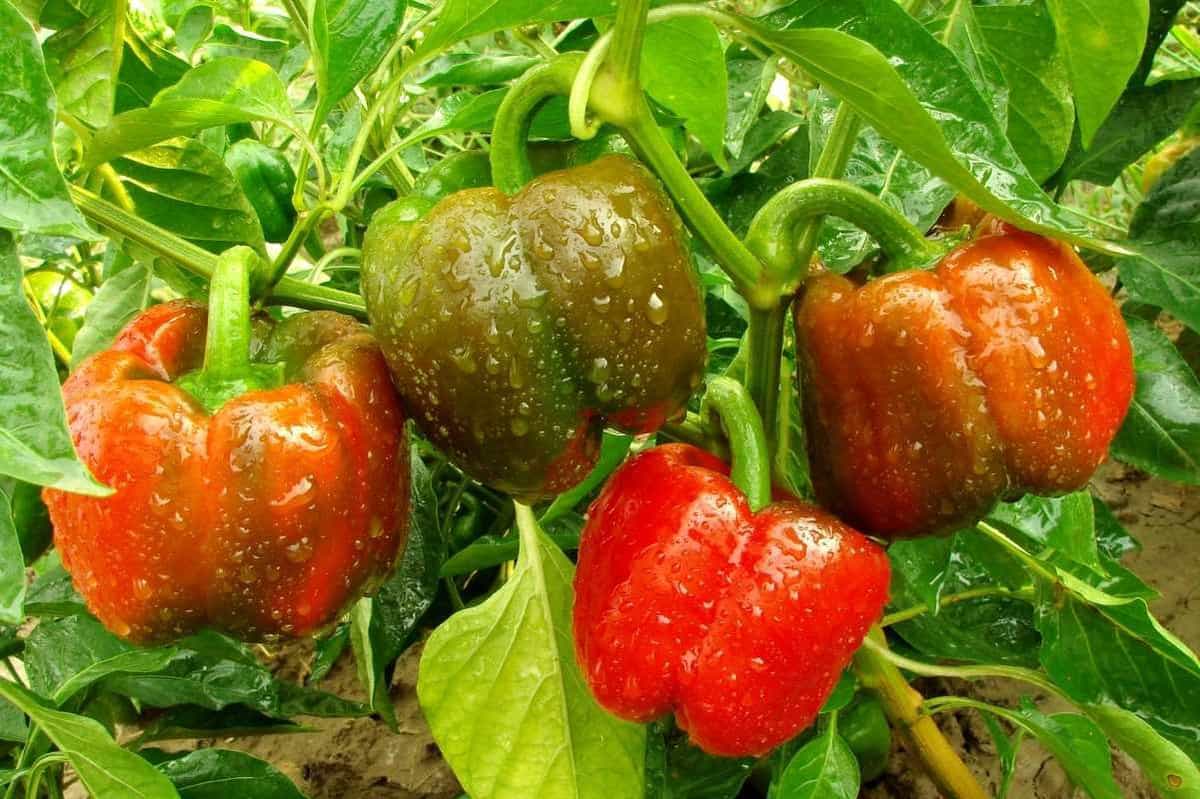
Bell pepper diseases and pests
For the most part, the challenging thing about growing bell peppers is making sure the temperature is right. Bell peppers are fairly resistant to pests and disease. Proper crop rotation, companion planting, and garden cleanliness go a long way towards keeping your bell pepper plants healthy.
Bell pepper pests:
- Spider mites create a fine webbing on the bottom of bell pepper leaves. They don’t like humid conditions, so if it’s been dry, mist the underside of your bell pepper leaves with water to discourage spider mites.
- Flea beetles cause a spray of tiny holes in bell pepper leaves. Using thick mulch and row covers can prevent these pests from making your bell peppers their home. Attracting beneficial insects by companion planting with carrots, dill, sunflowers, radish, and sweet alyssum can also help control flea beetle populations.
- Thrips are tiny sliver insects that can damage your bell pepper plants. Planting basil near your plants helps protect them from thrips. If an infestation occurs, get rid of these pests by using insecticidal soap, yellow sticky traps, or garlic spray. Beneficial insects such as lacewings, ladybugs, and praying mantis can also help control thrip populations.
- Tomato Hornworms eat the leaves and fruit of your plant, leading to loss of leaves. You can pick off hornworms by hand if you see them on the leaves. Tilling your soil in the spring and fall, rotating your crops, and planting dill and basil near your bell peppers can help prevent an infestation. If you see a hornworm covered in white eggs—leave it be! Those are a parasitic wasp that will dispose of the hornworm for you.
- Aphids are tiny bugs that cause yellowed leaves, misshapen fruit and flowers, and reduced harvests. They leave behind a sticky coating as they chew through your bell pepper plant. Aphids prefer to stay on the underside of leaves in a cluster. You can dislodge them with a stream of water. If you have an aphid infestation, a solution of water and dish soap or a sprinkling of diatomaceous earth can help eliminate the pests. Beneficial insects such as lacewings, ladybugs, and parasitic wasps help control aphids. Nasturtium can attract aphids away from your bell peppers and catnip planted near bell peppers also helps repel pests.
Growfully Protip
Avoid using diatomaceous earth when the plants are flowering, as it is harmful to beneficial insects like bees as well.
Bell pepper diseases:
- Blossom End Rot shows up as dark spots on the bottoms of your bell peppers that will get bigger and more sunken as time goes on. A calcium deficiency is the cause of blossom end rot. If you see blossom end rot, amend your soil with calcium supplements (we like crushed up egg shells or bone meal) and make sure that when you water, you water deeply and thoroughly. Shallow watering can prevent the calcium from traveling all the way to the end of the fruit—causing blossom end rot.
- Mosaic virus causes mottled leaves and distorted warty fruit. It spreads easily, so it’s crucial to destroy affected plants once it’s taken hold. Prevention is the best way to treat mosaic virus. Plant resistant varieties of bell peppers, and make sure you’ve cleaned up all garden debris from the previous year.
- Anthracnose is a fungus is a persistent thorn in our side of the hot and humid Growfully Gardens. This is a soil-based fungus that infects the plants when water splashes it onto the stems and leaves. Anthracnose doesn’t show many signs on the plant itself, but if you see round, black spots showing on ripe peppers that eventually spread and become rotten—you’ve probably got anthracnose. Once anthracnose is in your garden, it is hard to get rid of completely, but you can help reduce the spread by cleaning up infected debris and mulch, making sure your plants have good air circulation, watering at the base of the plant instead of above, and trying a preventative baking soda spray (like the one we recommend for treating powdery mildew).
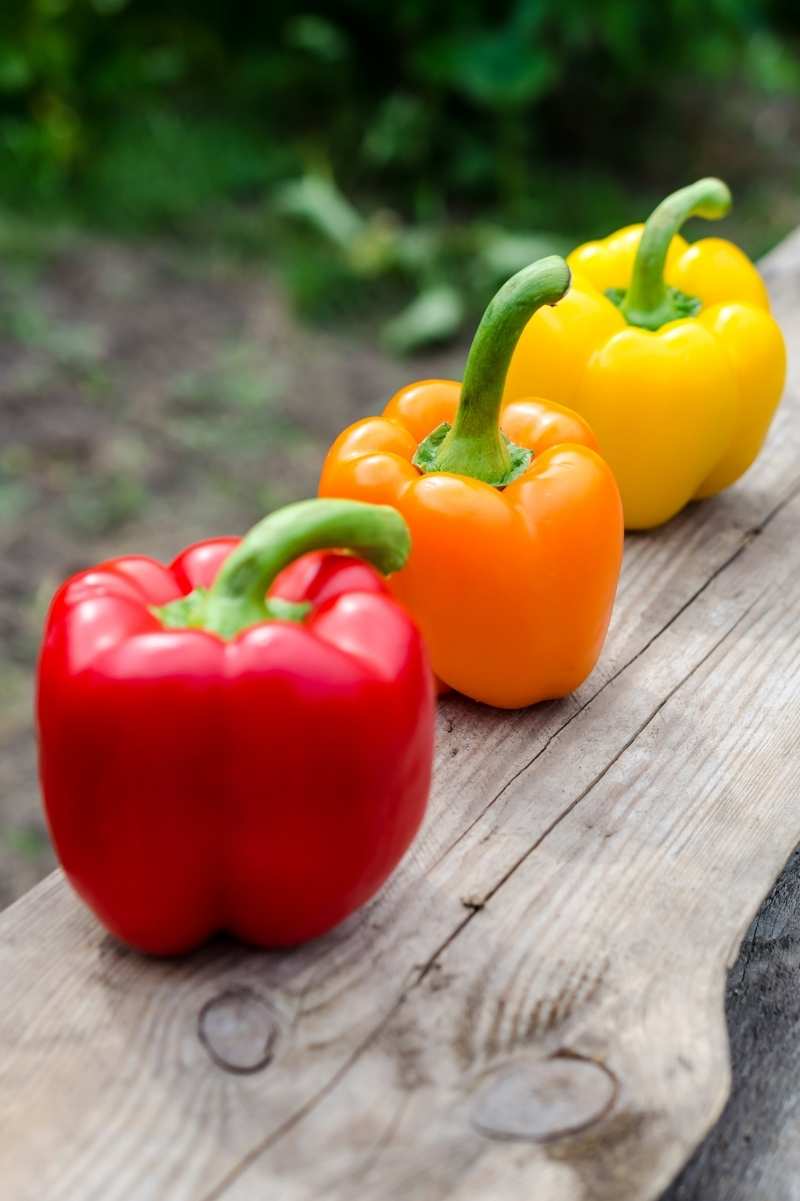
How many bell peppers will I get per plant?
The number of bell peppers you get off of each plant can change based on the variety you choose, the health of the peppers, and the growing conditions. Generally, you can expect anywhere from five to ten bell peppers off of each plant (even more for mini or small varieties). It’s recommended that you plant two to three bell pepper plants per person if you plan on only eating them fresh. If you plan on canning or freezing your bell peppers, you’ll want to plant extra plants.
Growfully Protip
Harvesting your bell peppers while they are green will encourage the plant to produce more flowers and more peppers. Leaving your bell peppers on the plant to mature to a yellow, orange, or red will cause the plant to produce fewer peppers; however, the peppers you pick will be sweeter. If you prefer to leave your peppers until maturity, try planting a few more plants to increase your harvest.
Harvesting bell peppers
You can harvest bell peppers at any stage of their development. Green peppers are less sweet than other colors because they’re the first stage of pepper development. The longer you leave your bell pepper on the plant, the sweeter it becomes.
Despite their thick stems, bell peppers are relatively fragile. You don’t want to rip the pepper off the plant. Instead, use a sharp knife or a pair of garden scissors to snip the bell pepper away from the stem.
How to store bell peppers
Refrigerate your bell peppers in plastic bags or Vejibags for up to ten days after harvest. You can also freeze bell peppers for up to a year. To freeze bell peppers, wash them carefully and remove the seeds. Slice or dice the peppers to the size you’ll need when cooking and lay them in a single layer on a cookie sheet. Freeze the sheet for two hours, then transfer the peppers to a glass or plastic freezer-safe container or bag.
Peppers may be water bath canned in approved and tested recipes (like this salsa), pressure canned, or dehydrated.

